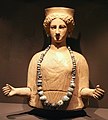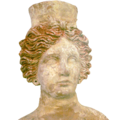Category:Tanit: Difference between revisions
Jump to navigation
Jump to search
Content deleted Content added
moved |
restoring basic |
||
| Line 1: | Line 1: | ||
{{it|Dea [[:Category:Phoenicia|fenicia]] e cananea della fertilità. I suoi fedeli incidevano il suo simbolo (un triangolo con un vertice verso l'altro, sormontato da una linea orizzontale e un cerchio) a scopo beneagurante.}} |
{{it|Dea [[:Category:Phoenicia|fenicia]] e cananea della fertilità. I suoi fedeli incidevano il suo simbolo (un triangolo con un vertice verso l'altro, sormontato da una linea orizzontale e un cerchio) a scopo beneagurante.}} |
||
| ⚫ | {{en|Tanit was a Phoenician goddess, now well-known for the Tanit symbol or sign, which occurs in a number of archaeological contexts with variations of form, but usually includes a circle (representing the head) above a horizontal line (representing outstretched arms) above a trapezoid or triangle.}} |
||
<!-- moved to [https://en.wikipedia.org/wiki/Talk:Tanit#From_Commons] -- JMCC1 |
|||
| ⚫ | {{en|Tanit was a Phoenician goddess, now well-known for the Tanit symbol or sign, which occurs in a number of archaeological contexts with variations of form, but usually includes a circle (representing the head) above a horizontal line (representing outstretched arms) above a trapezoid or triangle. |
||
A lunar (moon) goddess, worshipped as the patron goddess at Carthage where from the fifth century BCE onwards her name is associated with that of [[:Category:Baal Hammon|Baal Hammon]] and she is given the epithet ''pene baal'' ("face of Baal") and the title ''rabat'', the female form of ''rab'' (chief). Tanit was worshiped in Punic contexts in the Western Mediterranean, from Malta to Gades into Hellenistic times. In North Africa, where the inscriptions and material remains are more plentiful, she was, as well as a consort of Baal Hammon, a heavenly goddess of war, a virginal mother goddess and nurse, and, less specifically, a symbol of fertility. Several of the major Greek goddesses were identified with Tanit by the syncretic ''interpretatio graeca'', which recognized as Greek deities in foreign guise the gods of most of the surrounding non-Hellene cultures. Tanit was venerated by the Romans, after the fall of Carthage, under the name of ''Juno Caelestis'', and identified with their goddess Juno. Hvidberg-Hansen (Danish professor of Semitic philology), notes that Tanit is sometimes depicted with a lion's head, showing her warrior quality. <small>''-The Phoenician solar theology by Joseph Azize - Page 177''</small> |
|||
Her shrine excavated at Sarepta in southern Phoenicia revealed an inscription that identified her for the first time in her homeland and related her securely to the Phoenician goddess [[:Category:Astarte|Astarte]] (Ishtar). One site where Tanit was uncovered is at Kerkouan, in the Cap Bon peninsula in Tunisia.}} --> |
|||
[[Category:Fertility deities]] |
[[Category:Fertility deities]] |
||
Revision as of 07:40, 4 October 2013
Italiano: Dea fenicia e cananea della fertilità. I suoi fedeli incidevano il suo simbolo (un triangolo con un vertice verso l'altro, sormontato da una linea orizzontale e un cerchio) a scopo beneagurante.
English: Tanit was a Phoenician goddess, now well-known for the Tanit symbol or sign, which occurs in a number of archaeological contexts with variations of form, but usually includes a circle (representing the head) above a horizontal line (representing outstretched arms) above a trapezoid or triangle.
Subcategories
This category has the following 4 subcategories, out of 4 total.
5
C
G
S
Media in category "Tanit"
The following 52 files are in this category, out of 52 total.
-
066 Museu de Prehistòria de València, peveter ibèric del Puntal dels Llops, Olocau.jpg 2,112 × 2,816; 1.66 MB
-
Bardo National Museum tanit-edit.jpg 3,200 × 4,500; 4.7 MB
-
Bardo National Museum tanit.jpg 2,848 × 4,288; 3.91 MB
-
Carthage-Colosseo-Tanit.jpg 2,811 × 4,111; 1.03 MB
-
Dama oferente (26464491498).jpg 3,645 × 4,000; 1.09 MB
-
DSC00097 - Edicola funebre greco-punica da Marsala - Foto G. Dall'Orto.jpg 2,048 × 1,536; 1.32 MB
-
DSC00101 - Edicola funebre greco-punica da Marsala - Foto G. Dall'Orto.jpg 1,536 × 2,048; 2.52 MB
-
DSC00103 - Edicola funebre greco-punica da Marsala - Foto G. Dall'Orto.jpg 1,536 × 2,048; 1.41 MB
-
DSC00104 - Edicola funebre greco-punica da Marsala - Foto G. Dall'Orto.jpg 1,196 × 1,832; 1.86 MB
-
DSC00105 - Edicola funebre greco-punica da Marsala - Foto G. Dall'Orto.jpg 2,048 × 1,536; 2.65 MB
-
DSC00108 - Edicola funebre greco-punica da Marsala - Foto G. Dall'Orto.jpg 1,536 × 2,048; 1.25 MB
-
DSC00111 - Edicola funebre greco-punica da Marsala - Foto G. Dall'Orto.jpg 1,536 × 2,048; 1.3 MB
-
DSC00112 - Edicola funebre greco-punica da Marsala - Foto G. Dall'Orto.jpg 1,536 × 2,048; 1.33 MB
-
Estatuapunica.jpg 581 × 1,476; 83 KB
-
Hecht Museum, Israel – figurines 004-crop.JPG 1,320 × 1,980; 576 KB
-
Hecht Museum, Israel – figurines 004.JPG 1,944 × 2,592; 1.83 MB
-
Inscription punique Neapolis.JPG 3,560 × 2,656; 4.44 MB
-
Kanaanäische Inschriften 69Kanaanischeinsc00lidzgoog 0065 03.jpg 611 × 618; 86 KB
-
Musée Bardo 13.jpg 3,456 × 4,608; 5.25 MB
-
Musée national du Bardo, 2017-21.jpg 3,024 × 4,032; 1.72 MB
-
Niche-shaped aedicula.jpg 1,520 × 2,288; 936 KB
-
NMMI IMG 8966.JPG 1,315 × 3,629; 654 KB
-
Pebetero de Deméter-Tanit. Puntal dels Llops. Museo de Prehistoria de Valencia.jpg 6,456 × 4,304; 3.69 MB
-
Pebetero púnico-ebusitano de la diosa Tanit de Sanisera.JPG 1,536 × 2,048; 490 KB
-
Puig des molins Ibiza Terracota Tanit Cueva Es Cuieram (Sant Joan) sIIIaC.JPG 3,168 × 4,752; 6.91 MB
-
Puntal dels Llops (olocau) Pebetero Demeter-Tanit IIIaC.JPG 4,752 × 3,168; 6.96 MB
-
Representació guarnida de la deessa Tànit.JPG 2,083 × 2,319; 2.44 MB
-
Sarepta Tanit Inscription.png 972 × 660; 1.01 MB
-
Statue of goddess with a lion's head AvL.JPG 3,264 × 4,928; 2.65 MB
-
Tanit Cartagena.jpg 3,008 × 1,922; 1.27 MB
-
Tanit ibiza.jpg 745 × 1,117; 254 KB
-
Tanit ibiza.png 635 × 635; 406 KB
-
Tanit MuseuArqueologiaBarcelona.JPG 768 × 1,024; 185 KB
-
Tanit sign (fixed width).svg 16 × 16; 487 bytes
-
TanitHeiligtum.jpg 4,000 × 3,000; 4.02 MB
-
Terracota.jpg 511 × 827; 123 KB
-
Tossal-necropolis-pebetero.jpeg 320 × 475; 13 KB
-
Tunis Carthage Musée 4.jpg 2,304 × 3,072; 3.42 MB
-
Tunisie Néapolis musée 13.jpg 2,194 × 3,072; 2.84 MB
-
Tunisie Néapolis musée 15.jpg 2,300 × 3,150; 4.95 MB
-
Tunisie Néapolis musée 17.jpg 2,170 × 3,072; 3.6 MB
-
Túnez, El Bardo 1992 01.jpg 1,047 × 698; 402 KB
-
Vas de Tanit, detall de la deessa, l'Alcúdia, museu Arqueològic i d'Història d'Elx.jpg 4,523 × 3,071; 2.51 MB
-
Vaso de Tanit (43075593700).jpg 2,500 × 3,268; 1,009 KB
-
Vaso de Tanit (44167060834).jpg 2,500 × 3,250; 1.21 MB

















































